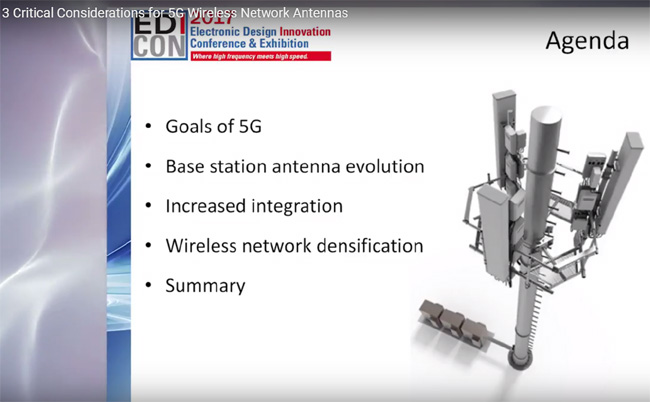Ray Butler, from Commscope, delivered a Frequency Matters Theater Keynote session at EDI CON USA2017. Ray and 5G Americas have been working toward developments for 5G requirements over the past three years and the future antenna systems will be key to managing network performance. The RAN and RF path will be critical in the arrival of 5G, with the need for a high signal to noise ratio for enhanced mobile broadband. Base station antennas, like speakers on a high-fidelity sound system, are critical to providing a high-performance signal and exceptional user experience. These antennas have evolved in parallel as wireless technology has evolved from 2G, 3G and 4G, and are on the road to 5G. The variety, complexity and application of base station antennas have increased exponentially, as have the number of frequency bands used by wireless network operators. Watch this session for a high-level view of antenna technology and how antennas will evolve for 5G. Below is the video of Ray’s full presentation.
Ray Butler is vice president of Wireless Network Engineering at CommScope, responsible for wireless technical sales leadership in outdoor Radio Frequency (RF) products. Having served on the Board of Governors at 5G Americas, Ray and Commscope often contribute to the highly regarded white papers for the association. Previously, Ray led the Research & Development team responsible for base station antennas, filters, combiners, remote radio heads and RF power amplifiers. He also worked for Andrew Corporation as vice president of base station antennas engineering, and systems engineering and solutions marketing, respectively. With 30 years of experience in wireless communications, Ray has served as director of national RF engineering with AT&T Wireless and vice president of engineering, research and development, and international operations at Metawave Communications, a smart antenna company. Ray was technical manager of systems engineering for Lucent Technologies Bell Laboratories, having also held other management positions responsible for the design of RF circuits, filters and amplifiers. He holds three patents related to smart antennas, and four additional RF path related patents are now pending. Ray holds a bachelors of science degree in electrical engineering from Brigham Young University and a master of science in electrical engineering from Polytechnic University. He is a member of Tau Beta Pi national engineering honor society and Eta Kappa Nu national electrical engineering honor society.

